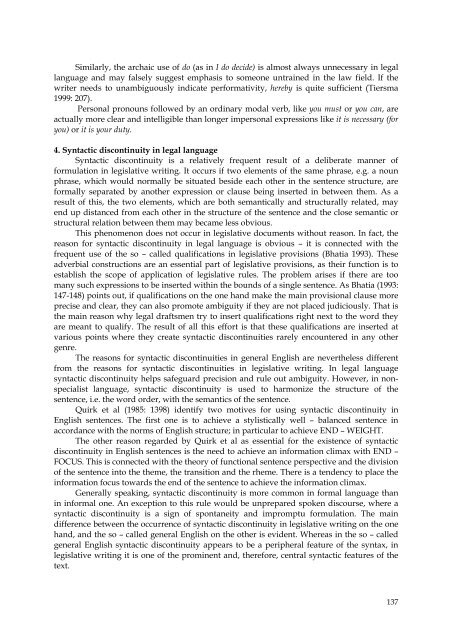Vol. 5/2009 - Facultatea de Litere
Vol. 5/2009 - Facultatea de Litere
Vol. 5/2009 - Facultatea de Litere
Create successful ePaper yourself
Turn your PDF publications into a flip-book with our unique Google optimized e-Paper software.
Similarly, the archaic use of do (as in I do <strong>de</strong>ci<strong>de</strong>) is almost always unnecessary in legal<br />
language and may falsely suggest emphasis to someone untrained in the law field. If the<br />
writer needs to unambiguously indicate performativity, hereby is quite sufficient (Tiersma<br />
1999: 207).<br />
Personal pronouns followed by an ordinary modal verb, like you must or you can, are<br />
actually more clear and intelligible than longer impersonal expressions like it is necessary (for<br />
you) or it is your duty.<br />
4. Syntactic discontinuity in legal language<br />
Syntactic discontinuity is a relatively frequent result of a <strong>de</strong>liberate manner of<br />
formulation in legislative writing. It occurs if two elements of the same phrase, e.g. a noun<br />
phrase, which would normally be situated besi<strong>de</strong> each other in the sentence structure, are<br />
formally separated by another expression or clause being inserted in between them. As a<br />
result of this, the two elements, which are both semantically and structurally related, may<br />
end up distanced from each other in the structure of the sentence and the close semantic or<br />
structural relation between them may became less obvious.<br />
This phenomenon does not occur in legislative documents without reason. In fact, the<br />
reason for syntactic discontinuity in legal language is obvious – it is connected with the<br />
frequent use of the so – called qualifications in legislative provisions (Bhatia 1993). These<br />
adverbial constructions are an essential part of legislative provisions, as their function is to<br />
establish the scope of application of legislative rules. The problem arises if there are too<br />
many such expressions to be inserted within the bounds of a single sentence. As Bhatia (1993:<br />
147-148) points out, if qualifications on the one hand make the main provisional clause more<br />
precise and clear, they can also promote ambiguity if they are not placed judiciously. That is<br />
the main reason why legal draftsmen try to insert qualifications right next to the word they<br />
are meant to qualify. The result of all this effort is that these qualifications are inserted at<br />
various points where they create syntactic discontinuities rarely encountered in any other<br />
genre.<br />
The reasons for syntactic discontinuities in general English are nevertheless different<br />
from the reasons for syntactic discontinuities in legislative writing. In legal language<br />
syntactic discontinuity helps safeguard precision and rule out ambiguity. However, in nonspecialist<br />
language, syntactic discontinuity is used to harmonize the structure of the<br />
sentence, i.e. the word or<strong>de</strong>r, with the semantics of the sentence.<br />
Quirk et al (1985: 1398) i<strong>de</strong>ntify two motives for using syntactic discontinuity in<br />
English sentences. The first one is to achieve a stylistically well – balanced sentence in<br />
accordance with the norms of English structure; in particular to achieve END – WEIGHT.<br />
The other reason regar<strong>de</strong>d by Quirk et al as essential for the existence of syntactic<br />
discontinuity in English sentences is the need to achieve an information climax with END –<br />
FOCUS. This is connected with the theory of functional sentence perspective and the division<br />
of the sentence into the theme, the transition and the rheme. There is a ten<strong>de</strong>ncy to place the<br />
information focus towards the end of the sentence to achieve the information climax.<br />
Generally speaking, syntactic discontinuity is more common in formal language than<br />
in informal one. An exception to this rule would be unprepared spoken discourse, where a<br />
syntactic discontinuity is a sign of spontaneity and impromptu formulation. The main<br />
difference between the occurrence of syntactic discontinuity in legislative writing on the one<br />
hand, and the so – called general English on the other is evi<strong>de</strong>nt. Whereas in the so – called<br />
general English syntactic discontinuity appears to be a peripheral feature of the syntax, in<br />
legislative writing it is one of the prominent and, therefore, central syntactic features of the<br />
text.<br />
137












